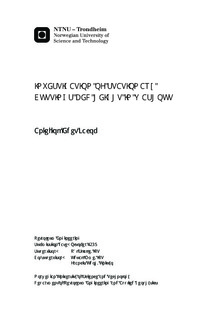| dc.description.abstract | Knowledge of the amount of cuttings that have accumulated in a drilled wellbore is part of the information necessary for the effective control of bottom-hole pressure, preventing stuck pipe and minimizing circulation time for cleaning the wellbore. Acquisition of this knowledge can be made difficult when washouts develop in the wellbore, thereby promoting uneven distribution of cuttings along different sections of the wellbore. The cuttings are essentially found to accumulate in the washouts causing the wells to be improperly cleaned and can also lead to stuck pipe scenarios and a host of other events causing Non Productive Time. This study was therefore conducted to investigate the stationary cuttings bed height in washouts and how long and wide the washouts need to be before any increase in height was expected. This was achieved by a theoretical and experimental approach. The theoretical approach involved a literature survey of issues relating to wellbore washouts such as its causes, basic indicators of its occurrence in a well, its effects on wellbore drilling and tripping processes as well as possible ways of minimizing these effects. In a bid to further unveil the concept of washouts in wellbores, a physical model was developed in the course of the work. Furthermore, a mathematical model useful for calculating the stationary cuttings bed heights in the washouts was also developed.The experimental work presented a detailed review of cuttings height in expansions. In order to verify this, a wellbore annulus with washout in the middle was simulated using a 6 m long loop. Three washouts of 60 cm, 30 cm and 15 cm in diameter respectively were used. The annulus was kept horizontal throughout the test period. Fluid flow rates were set in the frequency range of 5 to 30 Hz (28.6 l/min to 51.6 l/min). Water and aqueous solutions of hydroxyl ethyl cellulose polymer (HEC) were used for cleaning the cutting beds. Actual drill cuttings of were used. The stable cuttings bed height after long circulation as well as the effects of relevant drilling parameters was measured. During these tests, it was observed that a high Reynolds number leading to turbulent flow with low viscosity fluid (water) enabled cuttings to be removed in the largest washout diameter of 60 cm. It was equally observed that though cuttings accumulated in the washouts, it took an interval of 78 seconds at high flow rates for cuttings height increase to be seen in the largest washout, approximately 47 seconds for the 30 cm washout and 26 seconds for the 15 cm washout. This shows that washouts with wide diameters take much time to be filled with cuttings than when the washouts are smaller in diameter. However, the important issue here is the height of these cuttings in the washout sections.Experimental results were used together with a non-linear regression analysis program to establish a functional relationship among drilling fluid properties namely the fluid flow rate and the cuttings bed height. Finally, the results of non-linear regression analysis showed that the relationship between cuttings bed height and flow rate of mud in washouts could be described very well by a simple log-decay exponential expression: . | nb_NO |

